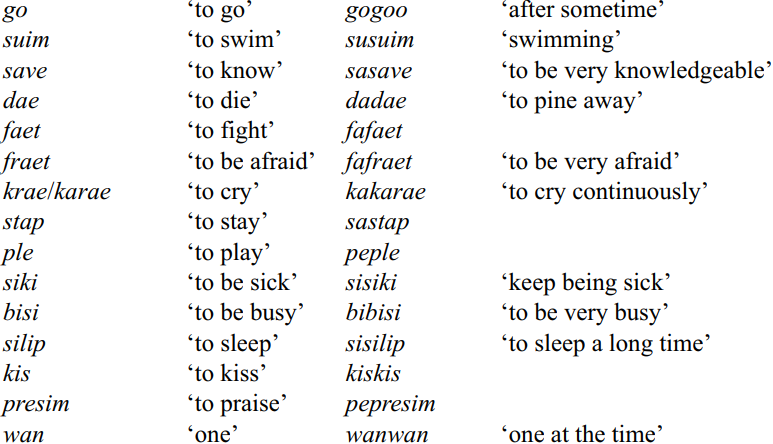


 Grammar
Grammar
 Tenses
Tenses
 Present
Present
 Past
Past
 Future
Future
 Parts Of Speech
Parts Of Speech
 Nouns
Nouns
 Verbs
Verbs
 Adverbs
Adverbs
 Adjectives
Adjectives
 Pronouns
Pronouns
 Pre Position
Pre Position
 Preposition by function
Preposition by function 
 Preposition by construction
Preposition by construction
 Conjunctions
Conjunctions
 Interjections
Interjections
 Grammar Rules
Grammar Rules
 Linguistics
Linguistics
 Semantics
Semantics
 Pragmatics
Pragmatics
 Reading Comprehension
Reading Comprehension
 Teaching Methods
Teaching Methods|
Read More
Date: 2023-12-05
Date: 2024-06-20
Date: 2024-03-05
|
Pijin makes room for reduplication as a productive pattern in the morphology of (primarily) verbs, where it can function to modify meaning or mood. It is also present in the substrate languages of the Solomon Islands, such that it remains to be seen whether the morphophonemic rules also correspond to those of the vernaculars. Reduplication may involve either full or partial reduplication of the first syllable.

The basic rule for verbal reduplication is to copy the first syllable of the verb and to prefix it to the root (e.g. sasave, sisiki, kiskis). However, contrary to what is happening in Bislama (Crowley, this volume), very rarely will speakers choose to duplicate a consonant cluster if it is in initial position. Instead, when the root starts with a cluster (a pattern predominantly found in the speech of young urbanites), speakers will copy the root’s first consonant and the first vowel only (e.g. fafraet, kakarae, sastap). It appears that in Pijin the more optimal reduplicant is maximally of the pattern CV. The same pattern holds for one-syllable verb roots containing a diphthong, where only the first vowel of the diphthong is reduplicated (e.g. dadae, fafaet). Interestingly, the coda is, however, retained in some other words whose roots-initial syllable is of the CVC pattern, such as in wanwan and kiskis.
|
|
|
|
لشعر لامع وكثيف وصحي.. وصفة تكشف "سرا آسيويا" قديما
|
|
|
|
|
|
|
كيفية الحفاظ على فرامل السيارة لضمان الأمان المثالي
|
|
|
|
|
|
|
شعبة مدارس الكفيل: مخيَّم بنات العقيدة يعزِّز القيم الدينية وينمِّي مهارات اتخاذ القرار لدى المتطوِّعات
|
|
|